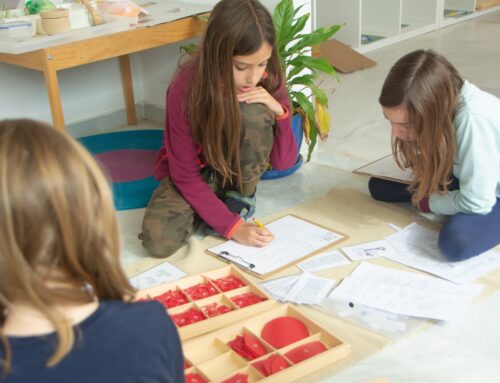The digital diet
In the previous blog article, we talked about the side effects of screens on the health and development of children, we gave some guidelines to detect if they are making abusive use of them, since there were many factors or symptoms for take into account that they could sound the alarm and we emphasized that the exposure time was not always the determining factor. Sometimes we realize this when the problem already exists. At other times, vacation periods can cause us to relax our limits and need to get back into our routine. Therefore, we may already know a lot about how to prevent, but once we have the problem, how can we help them as a family? If you want to help your children in the responsible use of digital resources, take note to follow a “digital diet” at home, since correct access to new technologies will depend, above all, on the education received from the children. parents.
How can we intervene? Some tips are:
From a very young age, avoid exposure at home: It is almost inevitable that they are exposed to screens, but when they are younger the situations are manageable and easier. If they do not see its use, they do not ask for it, if they do not have it, they do not incorporate it into their routines, therefore, the later the better and the less the better.

The frequent use of screens greatly affects their development at different levels, above all, it affects vision, language, understanding of social situations, understanding of the real world that surrounds them, of the natural rhythms of life, etc Therefore, our recommendation is zero screens until the age of two or three, less than an hour with presence and high-quality content (slow-paced images, as real as possible, academically nutritious, not too strident, without stimuli). as reinforcements for their interaction, etc.). Until 6 years old and from that age onwards, review their interests, be consistent over time according to the content, but finding the balance in which they are very aware of the limits that have been established. Communicating clear times and limits according to age helps you manage yourself. The use of visual clocks is highly recommended to help them control time, for example, stopwatches, hourglasses, etc.
Educate by example and with consistency with what happens at home: Small details count and children perceive them, even the decoration can help. Encourage a sofa facing a bookcase instead of a television or at least downplaying it will be a great help, and even not having it. Always keep it off and turn it on judiciously. Make responsible use of screens in their presence, encourage communication, sports, recreational activities, etc. If you make abusive use due to force majeure, you can explain according to age what you use it for (for example, for work as a tool) and the differences in how it affects your development as an adult and theirs as a child.
Be consistent with what happens in your own home, for example, if as adults you love playing video games and it is an activity that you do in their presence, it is logical that he or she wants to play video games and the effort will be to delimit times, types of games, etc., but it will not make sense to prohibit him from playing them or to focus on a negative attitude towards screens.
Once the use is increasingly present: Know why it traps us in order to prevent them, know the risks and inform people. There is a gap between parents and children regarding the use of tools that we may not know about and we must prepare to inform them.
Knowing what makes it so addictive and explaining it to children according to their age is important to make them participate and more agree with the limits established at home regarding its use. Although technology is there to help us, many developers have taken great care of knowing what captures and motivates people so that it is practically technology that consumes us:
- Identify continuous reward systems in games that trigger dopamine and double the need and motivation for games.
- Identify elements of continuous stimulation in games.
- Games that allow us to change and play with identity, where the consequences in the game go unnoticed and impossible to replicate in real life (killing opponents, being a superhero, etc.) and where every day you can be a person or different character with different values, ethics and morality.
- Tools that monitor everything we do: notifications, heart rate, number of steps, task lists, etc.
- Tools that allow you to set goals, popularity (count the number of “friends”, count likes, followers, publications, etc.).
- Tools that make consumption easier for us, show us what they know we want to see, what we want to buy, etc.
- Tools that generate emotional relief (micro games that take us out of everyday life, shorts, etc.).
- Tools that keep us socially connected at all hours (networks, chat channels, etc.).
- Tools and games that make you loyal to them so that you cannot stop playing or accessing them (games that offer a novelty available only if you access within 24 hours or lose accumulated points and similar).
In short, help them become aware of using technology to their advantage and not being consumed by it.
Use technology to your advantage: Show them how to make responsible searches for content on reliable pages for their projects or research their interests or other tools (text editing tools, photos, video, robotics, programming, etc.).
Download parental control tools (check that they are tools that cannot be skipped). There are tools that show you the time you have spent in each game or application, for example, Android Pie makes comparisons and you can show you the total number of hours per week for joint reflection on the use of leisure time and identify the problematic tool or risk. Parental control tools are a great help, some have the option of blocking inappropriate content so that it does not appear on the Tablet or so that the screen we choose cannot be turned on until a specific time and turns off at the time you want. There are also options so that a specific tool can only be used a maximum number of hours per week and cannot be opened until the beginning of the next week, etc.

Set switches: Bring him into real life, get closer and ask him from time to time what he does, what he sees, etc. Remind him little by little of the time he has left: “30 minutes have already passed, remember that you only have another 30 left”, “50 minutes have passed, in 10 minutes you have to turn off, there are 5 minutes left, finish and close” .
If things start to get a little complicated… We continue giving you some tips.
Small achievable goals: You may find yourself in need, due to suspicion of abusive use, to want to lower the established time or simply recover it after a different situation, for example, after Christmas, vacations, illness, etc. Whatever it is, it is best to do it progressively. If it is two hours a day and we only want one, some days we will give it an hour and a half, then one and a quarter and so on until we reach the hour. If we only want weekends, we can start every other day, a single day during the week and, finally, only on the weekend. Sometimes, in extreme cases, it is recommended to cut the use of everything to nothing. In general, when these cases occur, the child and family should already be being cared for or advised by a psychologist or other clinical specialist. We are referring to situations considered as addictive or extreme behavioral disorders that pose a physical or emotional danger to the child or if these situations cause cyberbullying, or in cases of anorexia so that they do not access pro-anorexia pages, or in cases in which you are accessing self-harming, pornographic content, pro-violence pages, etc.
Make a list: You can encourage him to make a list of things that he has stopped doing or that are happening since he is using more screen time or the conflicting tool: stopping going out with friends , not wanting to play anything, having more fights with his brothers, etc.
Family commitments: Generates motivation to do other things with interesting proposals. Activities that may be of interest to you, outings to the countryside, hangouts with friends, sports, family board games, etc.

When the situation particularly worries us, we see that the 10 factors explained in the previous blog article exist and in addition the family intervention does not seem to give a positive response, it is important to outsource to professionals who are experts in the field, such as pediatricians or child psychologists. -youth.
We hope that this article helps you reflect on the use of screens at home and encourages you to practice a good “digital diet” and responsible education in the use of digital devices. For our part and in our school environment, the Montessori method does not use screens as a regular means of learning. Until the age of 6, children do not have digital resources. In Workshop 1 (from 6 to 9 years old), boys and girls can request to use the digital resource as a specific tool under the supervision, guidance and consensus with the Montessori Guide. In the case of Workshop 2 (from 9 to 12 years old) they do have an ICT point with a computer and tablet in the environment as one more resource that they use occasionally to achieve specific learning objectives for the acquisition of digital skills. established by the Ministry of Education.

Our own values as a school, our continuous look at the results obtained from different experiences, the digitalization of the school in thousands of educational centers around the world, as well as our continuous training in Neurodevelopment and Affective Neuroscience and our vision as teachers, pedagogues and Montessori guides, make us believe faithfully that true educational innovation is not screens but the humanization of education resorting to true human needs as the references that mark the path and these needs are very far from the use of screens in the school context. The balance in the use of these tools as what they are will be what marks a normality so that they can be integrated as another resource and never replace fundamental processes and resources in the lives of boys and girls.


















